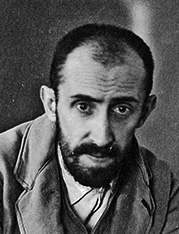Search for Names, Places and Biographies
Already layed Stumbling Stones
Suche
Louis Sommer * 1877
Grindelhof 12 (ehemals Hausnummer 14 b) (Eimsbüttel, Rotherbaum)
HIER WOHNTE
LOUIS SOMMER
JG. 1877
EINGEWIESEN 1913
HEILANSTALT LANGENHORN
"VERLEGT" 23.9.1940
BRANDENBURG
ERMORDET 23.9.1940
"AKTION T4"
Louis Sommer, born on 20 Aug. 1877 in Hamburg, murdered on 23 Sept. 1940 in the Brandenburg/Havel euthanasia killing center
Stolperstein in Hamburg-Rotherbaum, at Grindelhof, to the left of house no. 12 (formerly house no. 14 B, house 16).
Schauenburger Strasse, where Louis Sommer was born in 1877, is located in Hamburg’s historic downtown. The Jewish population of Hamburg concentrated there and in Hamburg-Neustadt during the 1870s. Louis’ parents were the tailor and clothes dealer Aron Sommer and the tailor’s daughter Rebecca Rieke Pincus.
We know nothing about Louis Sommer’s childhood, youth, and school education. The commercial clerk Louis Sommer lived on Grindelhof in the Hamburg Rotherbaum quarter, when he was admitted for the first time in spring 1903 to the "Friedrichsberg lunatic asylum” ("Irrenanstalt Friedrichsberg”). The diagnosis was "mental deficiency.” Interrupted by some periods of leave with his parents, he spent ten years in Friedrichsberg. In July 1913, he was transferred to the "Langenhorn lunatic asylum” ("Irrenanstalt Langenhorn”) and spent the next 15 years there. The doctors described him as "pale and slight.” His behavior was reportedly apathetic, but also excitable and irritable. Apparently, he could not be persuaded to engage in any occupation.
In the mid 1920s, the number of patients at the Langenhorn State Hospital increased drastically, so that the need for a third sanatorium and nursing home in addition to the existing ones in Friedrichsberg and Langenhorn could no longer be denied. Instead of a new building, however, the Hamburg authorities opted for referral agreements with non-Hamburg institutions, which then admitted patients from Hamburg. In 1928, 50 Langenhorn patients came to the "Princely Lippische sanatorium and nursing home” (Fürstlich Lippische Heil- und Pflegeanstalt) in Lindenhaus near Lemgo in what is now North Rhine-Westphalia based on an agreement with the State of Lippe. One of them was Louis Sommer, who arrived at Lindenhaus on 4 June 1928.
When he was admitted to the Lippische institution, he was found to be in poor nutritional condition, which gradually improved.
On 15 Sept. 1930, Louis Sommer returned to the State Hospital in Hamburg-Langenhorn. There, too, the doctors found a modest nutritional status. Louis Sommer’s behavior had not changed in relation to that during his earlier stay in Langenhorn.
On 19 Jan. 1933, Louis Sommer was transferred to the Hamburg department of the "Strecknitz Lübische sanatorium” ("Lübische Heilanstalt Strecknitz”). This department was another important relief facility for the institution in Langenhorn. Based on an agreement between Hamburg and Lübeck, the city on the Elbe had financed the construction of new buildings at the Strecknitz institution in Lübeck with loans and had secured extensive occupancy rights for these "Hamburg houses.”
In the spring/summer of 1940, the "euthanasia” headquarters in Berlin, located at Tiergartenstrasse 4, planned a special operation aimed against Jews in public and private sanatoriums and nursing homes. It had the Jewish persons living in the institutions registered and moved together in what were officially so-called collection institutions. The Hamburg-Langenhorn "sanatorium and nursing home” ("Heil- und Pflegeanstalt” Hamburg-Langenhorn) was designated the North German collection institution. All institutions in Hamburg, Schleswig-Holstein, and Mecklenburg were ordered to move the Jews living in their facilities there by 18 Sept. 1940.
Louis Sommer arrived in Langenhorn on 16 Sept. 1940. On 23 Sept. 1940, he was taken by train with a further 135 patients from North German institutions to Brandenburg/Havel. The transport reached the city in the Mark (March) on the same day. In the part of the former penitentiary that had been converted into a gas-killing facility, the patients were immediately driven into the gas chamber and murdered with carbon monoxide. Only Ilse Herta Zachmann escaped this fate at first (see corresponding entry).
It is not known whether, and if so, when relatives became aware of Louis Sommer’s death. In all documented death notices, it was claimed that the person concerned had died in Chelm (Polish) or Cholm (German). Those murdered in Brandenburg, however, were never in Chelm/Cholm, a town east of Lublin. The former Polish sanatorium there no longer existed after SS units had murdered almost all patients on 12 Jan. 1940. Also, there was no German records office in Chelm. Its fabrication and the use of postdated dates of death served to disguise the killing operation and at the same time enabled the authorities to claim higher care expenses for periods extended accordingly.
Louis Sommer is commemorated by a Stolperstein in Hamburg-Rotherbaum on Grindelhof, to the left of house no. 12 (formerly house no. 14 B, house 16).
Translator: Erwin Fink
Kindly supported by the Hermann Reemtsma Stiftung, Hamburg.
Stand: March 2020
© Ingo Wille
Quellen: 1; 4; 5; StaH 133-1 III Staatsarchiv III, 3171-2/4 U.A. 4, Liste psychisch kranker jüdischer Patientinnen und Patienten der psychiatrischen Anstalt Langenhorn, die aufgrund nationalsozialistischer "Euthanasie"-Maßnahmen ermordet wurden, zusammengestellt von Peter von Rönn, Hamburg (Projektgruppe zur Erforschung des Schicksals psychisch Kranker in Langenhorn); 332-3 Zivilstandsaufsicht B69 Heiratsregister Aron Sommer/Rebecca (Rieke) Pincus; 332-5 Standesämter 1898 Geburtsregister Nr. 3221/1877 Louis Sommer, 352-8/7 Staatskrankenanstalt Langenhorn Abl. 1/1995 Zu-/Abgangsbuch 26. 8. 1939-27. 1. 1941; 352-8/7 Staatskrankenanstalt Langenhorn Abl. 2/1995 6780 Louis Sommer; UKE/IGEM, Archiv, Patienten-Karteikarte Louis Sommer der Staatskrankenanstalt Friedrichsberg; IMGWF Lübeck, Archiv, Patientenakte Louis Sommer der Heilanstalt Lübeck-Strecknitz; Landesarchiv Nordrhein-Westfalen, Abteilung Ostwestfalen-Lippe, L107_D_Nr5122, Louis Sommer, Lindenhaus; JSHD Forschungsgruppe "Juden in Schleswig-Holstein", Datenpool Erich Koch, Schleswig. Böhme/Lohalm, Wege in den Tod, S. 30; Foth, Thomas, Caring and killing – Nursing und Psychiatric Practice in Germany 1931–1945, S. 84, Osnabrück 2013. Bender, Wolfgang, Aus der Versenkung geborgen – Die Patientenakten der Heil- und Pflegeanstalt Lindenhaus, in: Rosenland, Zeitschrift für lippische Geschichte, (2011) 12, S. 53–56.
Zur Nummerierung häufig genutzter Quellen siehe Link "Recherche und Quellen".


